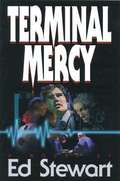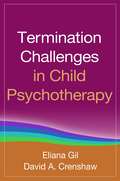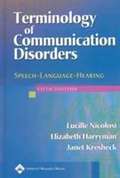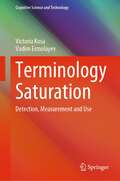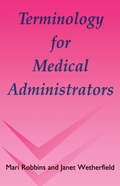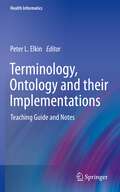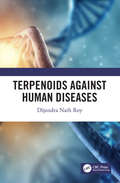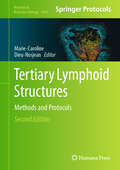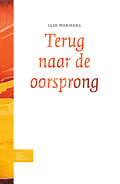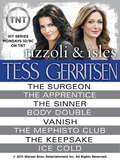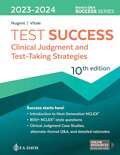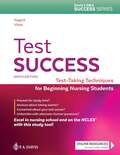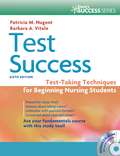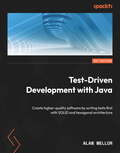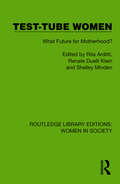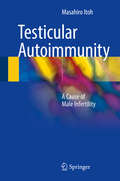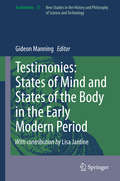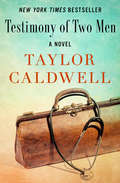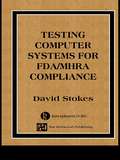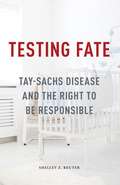- Table View
- List View
Terminal Mercy
by Edward StewartDr. Jordan Keyes fights to save his patients, his career, and his own life as he becomes entangled in a web of deceit, genetic testing, and murder. Jordan must also fight the forces within himself to become the husband his wife deserves in order to save his marriage. this book is a contemporary medical thriller.
Termination Challenges in Child Psychotherapy
by Eliana Gil David A. CrenshawEnding therapy in an appropriate and meaningful way is especially important in work with children and adolescents, yet the topic is often overlooked in clinical training. From leading child clinicians, this much-needed book examines the termination process/m-/both for brief and longer-term encounters/m-/and offers practical guidance illustrated with vivid case material. Tools are provided for helping children and families understand termination and work through associated feelings of loss and grief. Challenges in creating positive endings to therapy with children who have experienced trauma and adversity are given particular attention. Several reproducible forms can be downloaded and printed from the companion website in a convenient 8 1/2" x 11" size. This e-book edition features nine full-color figures. (Figures will appear in black and white on black-and-white e-readers).
Terminology Of Communication Disorders: Speech-Language-Hearing
by Lucille Nicolosi Elizabeth Harryman Janet KresheckThe leading dictionary/sourcebook of terms for speech, language, and hearing pathology, Terminology of Communication Disorders is intended for students in speech, language, and hearing disorders programs, faculty, and practitioners. Terms are listed alphabetically and cross-referenced for synonyms and related terms, accommodating the sometimes complex classifications of Speech, Language, and Hearing disorders.
Terminology Saturation: Detection, Measurement and Use (Cognitive Science and Technology)
by Vadim Ermolayev Victoria KosaThis book highlights an innovative approach for extracting terminological cores from subject domain-bounded collections of professional texts. The approach is based on exploiting the phenomenon of terminological saturation. The book presents the formal framework for the method of detecting and measuring terminological saturation as a successive approximation process. It further offers the suite of the algorithms that implement the method in the software and comprehensively evaluates all the aspects of the method and possible input configurations in the experiments on synthetic and real collections of texts in several subject domains. The book demonstrates the use of the developed method and software pipeline in industrial and academic use cases. It also outlines the potential benefits of the method for the adoption in industry.
Terminology and Terminological Systems
by Peter L. ElkinThis book will provide readers with the essential information needed to understand knowledge representation with a focus on healthcare. The book will use health sector real world examples to delineate the principal issues and solutions for the field of data representation. The book will include a history of terminologies and in particular their use in healthcare. This book will cover the basis, authoring and use of reference terminologies including the formalisms needed to use them safely. The editor will exhaustively cover the field of concept-based indexing and will provide readers with an understanding of natural language processing and its application to health terminologies. The book will discuss terminology services and the architecture for terminological servers. This text will serve as the basis for a course or equally well as a reference text.
Terminology for Medical Administrators
by Mari Robbins Janet WetherfieldMany refugees and asylum seekers now in the United Kingdom have trained and worked as doctors nurses midwives and other professionals allied to medicine in the countries from which they have departed. However refugees face considerable problems and difficulties in their quest to continue or resume their careers as health professionals in the UK. This book has brought together authors from varying organisations and professional backgrounds who are dedicated to supporting the integration of refugee doctors into the National Health Service workforce. It is timely and informative for all those working with refugee doctors in the NHS and a useful handbook for refugee doctors themselves. It will help all refugee doctors use their qualifications and expertise in the UK and maximise their contribution to the NHS workforce. All members of workforce development confederations strategic health authorities NHS trusts and primary care organisations and refugee doctors wishing to work in the NHS in the UK will find this book invaluable reading. 'This book gives a very full account of many aspects of a complex situation. It details the history of refugee doctors and the range of problems that they face and also shows the contribution that they can make and the personal courage and resilience it takes to survive the transition. It outlines practical steps from improving English to preparation for examinations they must pass and preparing for job interviews in a competitive market.' Dame Lesley Southgate President Royal Free and University College Medical School London and Past President Royal College of General Practitioners
Terminology, Ontology and their Implementations (Health Informatics)
by Peter L. ElkinThis revised new edition containing numerous new and heavily updated chapters provides readers with the essential information needed to understand the central topics of terminology in healthcare, the understanding of which is an asset to be leveraged in care and research. Twenty-five years ago the notion that terminology should be concept-based was all but unknown in healthcare; now almost all important terminologies are at least partly concept-based. With no general model of what a terminology was or should be, there were no tools to support terminology development and maintenance. Steady progress since then has improved both terminology content and the technology and processes used to sustain that content. This new edition uses real world examples from the health sector to delineate the principal issues and solutions for the field of data representation. It includes a history of terminologies and in particular their use in healthcare, including inter-enterprise clinical and research data aggregation. Terminology, Ontology and their Implementations covers the basis, authoring and use of ontologies and reference terminologies including the formalisms needed to use them safely. The editor and his team of carefully chosen contributors exhaustively reviews the field of concept-based indexing and provides readers with an understanding of natural language processing and its application to health terminologies. The book discusses terminology services and the architecture for terminological servers and consequently serves as the basis for study for all students of health informatics.
Terminology, Ontology and their Implementations: Teaching Guide and Notes (Health Informatics)
by Peter L. ElkinThis set of teaching notes provides extensive guidance for educators related to its sister title and contains numerous tools and questions to help educators provide didactics and evaluation of students in this essential area of biomedical informatics. This is needed to understand the central topics of ontology, terminology and terminological systems in healthcare. Twenty-five years ago the notion that ontology would be essential to knowledge representation in healthcare was all but unknown. Almost all important terminologies and many ontologies are now in wide use and are growing in importance. With no general model of what a ontology and terminology should be, there are an increasing number of tools to support ontology / terminology development, implementation and maintenance. Steady progress since then has improved both ontology / terminology content and the technology and processes used to sustain that content. Terminology, Ontology and their Implementations: Teaching Guide and Notes provides extensive teaching materials to accompany Terminology, Ontology and their Implementations . It provides further definition of the topic and explains the use of reference terminologies needed to use them safely. It contains questions and explanations from each section of the textbook, making it easier to use the text in teaching Health Informatics students. The authors also provide supplementary information about the questions, their relevance and their relation to other concepts. This book augments Terminology, Ontology and their Implementations by assisting the understanding of terminology services and the architecture for terminological servers, and consequently serves as an essential tool for educators in their efforts to teach students in their study of health informatics.
Terpenoids Against Human Diseases
by Dijendra Nath RoyThis book highlights how terpenoids act as biological messengers and can be used as medicine against liver disease, neurodegenerative disease, cancer, infectious disease, cardiovascular disease, and inflammatory diseases. It emphasizes the metabolic engineering approach of terpenoids production and their toxicity.
Terpenoids: Chemistry, Biochemistry, Medicinal Effects, Ethno-pharmacology
by Biswa Mohan Sahoo Bimal Krishna Banik Abhishek TiwariThis unique volume covers specific aspects of the biological chemistry of terpenoids. It provides extensive information related to classification, general methods of extraction and isolation of terpenoids, synthesis and pharmacological activities of monoterpenoids, synthesis and medicinal uses of diterpenoids, biogenesis of terpenoids, synthesis and medicinal uses of sesqui terpenoids and sesterpenoids. Some terpenes are also classified as diterpene alkaloids. Most of the terpenoids with diverse molecular structures are biologically active and are used for the treatment of various diseases such as cancer, malaria, inflammation, tuberculosis and infection, and this is discussed. Features: Activities and biological relationships of terpenes An accurate assessment of where and what terpenes can lead to Discusses how microbes, in particular the actinomycetales, have well over 400 different gene clusters that produce terpenes Arranged by biological activities and usage Provides information on eukaryotic enzymes that have been shown to be a source of “ethnobotanical” terpenes
Tertiary Lymphoid Structures: Methods and Protocols (Methods in Molecular Biology #1845)
by Marie-Caroline Dieu-NosjeanThis volume explores the various methods used to study tertiary lymphoid structures (TLS) in pathological situations. Pre-clinical models are also discussed in detail to show how TLS structure, development, and maintenance can be targeted and studied in vivo. The chapters in this book cover topics such as humans and mice; strategies to quantify TLS in order to use it in stained tissue sections; classifying a gene signature form fixed and paraffin-embedded tissues; and development of murine inflammatory models to help look at TLS in the context of infection or malignancy. Written in the highly successful Methods in Molecular Biology series format, chapters include introductions to their respective topics, lists of the necessary materials and reagents, step-by-step, readily reproducible laboratory protocols, and tips on troubleshooting and avoiding known pitfalls. Authoritative and thorough, Tertiary Lymphoid Structures: Methods and Protocols is a valuable resource that increases the reader’s knowledge on immune functions and how they will pave the way to future therapeutic applications.
Tertiary Lymphoid Structures: Methods and Protocols (Methods in Molecular Biology #2864)
by Marie-Caroline Dieu-NosjeanThis second edition details new and updated chapters on technologies related to tertiary lymphoid structures( TLS). Chapters guide readers through TLS in cancers, different stages of TLS development, immune function of TLS, molecular, cellular, and imaging methods, and preclinical methods to uncover the function of cells composing TLS in inflammatory situations in humans. Written in the highly successful Methods in Molecular Biology series format, chapters include introductions to their respective topics, lists of the necessary materials and reagents, step-by-step, readily reproducible laboratory protocols, and key tips on troubleshooting and avoiding known pitfalls. Authoritative and cutting-edge, Tertiary Lymphoid Structures: Methods and Protocols, Second Edition aims to guide you through techniques and methods used to study the biology of TLS.
Terug naar de oorsprong
by Ilse WarnersOver mensen met dementie, hun belevingswereld die van zorgverleners, is veel te zeggen. Wat is de betekenis van dementie voor de persoon in kwestie en wat vergt dit van zorgverleners aan menselijkheid en menslievendheid? Gepleit wordt voor een herwaardering van wat vaak voor een onaf, onvoltooid, oneigenlijk of onvolwaardig leven doorgaat. Terwijl mensen met dementie doodgewone mensen zijn aan wie niets menselijks vreemd is en die signalen uitzenden waarop slechts met ontferming is te antwoorden.
Tess Gerritsen's Rizzoli & Isles 8-Book Bundle
by Tess GerritsenNew York Times bestselling author Tess Gerritsen has thrilled countless readers with her acclaimed novels of suspense featuring Boston detective Jane Rizzoli and medical examiner Maura Isles--and TNT struck ratings gold with the Rizzoli & Isles series based on Gerritsen's novels. Now here's a convenient e-book bundle of the first eight installments of this compelling series: The Surgeon, The Apprentice, The Sinner, Body Double, Vanish, The Mephisto Club, The Keepsake, and Ice Cold. Includes an exclusive script excerpt from the TNT series and a special preview of Tess Gerritsen's new Rizzoli & Isles novel, The Silent Girl, on sale July 5, 2011
Test Success: Clinical Judgment And Test-taking Strategies (Davis's Q&a Success Ser.)
by Patricia M. Nugent Barbara A. VitaleStrategies for a great start. Practice questions for success. Reduce the stress and anxiety you feel before an exam with test-taking strategies that really work. Practice questions introduce you to the NCLEX®-style questions you’ll encounter throughout your nursing education while developing the critical-thinking and clinical judgment skills essential to success on the Next Gen NCLEX. A complete review of core concepts, and more than 900 questions based on the latest NCLEX test plan build confidence and improve test scores from the beginning of nursing school. Master the challenging alternate-format questions, even SATA (select-all-that-apply) and develop your studying skills with test-taking tips and rationales for correct and incorrect responses.
Test Success: Test-Taking Techniques for Beginning Nursing Students
by Patricia Nugent Barbara VitaleA complete review of core concepts, plus 900 questions based on the latest NCLEX© test plan will build confidence and improve test scores from the beginning of nursing school. Master tricky alternate-format questions, even SATA (select all that apply) and develop efficient studying skills with test-taking tips and rationales for correct and incorrect responses.
Test Success: Test-taking Techniques For Beginning Nursing Students
by Patricia M. Nugent Barbara A. VitaleBuild confidence and improve test scores. Success in nursing school starts here. A complete review of core concepts 900 questions (Alternate format, too!) Test-taking hints and rationales for correct and incorrect answers A complete review of core concepts, plus 900 questions based on the latest NCLEX© test plan build confidence and improve test scores from the beginning of nursing school. Master tricky alternate-format questions, even SATA (select all that apply), and develop efficient studying skills with test-taking tips and rationales for correct and incorrect responses. Purchase this title NEW and get 150 additional questions online plus all of the questions in the book.
Test Success: Test-taking Techniques for Beginning Nursing Students (6th Edition)
by Patricia M. Nugent Barbara A. VitaleThe road to nursing success begins here! A complete review of core concepts. More than 800 questions (Alternate format, too!) Test-taking hints and rationales for correct and incorrect answers.
Test-Driven Development with Java: Create higher-quality software by writing tests first with SOLID and hexagonal architecture
by Alan MellorDrive development with automated tests and gain the confidence you need to write high-quality softwareKey FeaturesGet up and running with common design patterns and TDD best practicesLearn to apply the rhythms of TDD – arrange, act, assert and red, green, refactorUnderstand the challenges of implementing TDD in the Java ecosystem and build a planBook DescriptionTest-driven development enables developers to craft well-designed code and prevent defects. It's a simple yet powerful tool that helps you focus on your code design, while automatically checking that your code works correctly. Mastering TDD will enable you to effectively utilize design patterns and become a proficient software architect.The book begins by explaining the basics of good code and bad code, bursting common myths, and why Test-driven development is crucial. You'll then gradually move toward building a sample application using TDD, where you'll apply the two key rhythms -- red, green, refactor and arrange, act, assert. Next, you'll learn how to bring external systems such as databases under control by using dependency inversion and test doubles. As you advance, you'll delve into advanced design techniques such as SOLID patterns, refactoring, and hexagonal architecture. You'll also balance your use of fast, repeatable unit tests against integration tests using the test pyramid as a guide. The concluding chapters will show you how to implement TDD in real-world use cases and scenarios and develop a modern REST microservice backed by a Postgres database in Java 17.By the end of this book, you'll be thinking differently about how you design code for simplicity and how correctness can be baked in as you go.What you will learnDiscover how to write effective test cases in JavaExplore how TDD can be incorporated into crafting softwareFind out how to write reusable and robust code in JavaUncover common myths about TDD and understand its effectivenessUnderstand the accurate rhythm of implementing TDDGet to grips with the process of refactoring and see how it affects the TDD processWho this book is forThis book is for expert Java developers and software architects crafting high-quality software in Java. Test-Driven Development with Java can be picked up by anyone with a strong working experience in Java who is planning to use Test-driven development for their upcoming projects.
Test-Tube Women: What Future for Motherhood? (Routledge Library Editions: Women in Society)
by Rita Arditti Renate Duelli Klein Shelley MindenOriginally published in 1984, when new reproductive technologies were just beginning to become part of the public discussion, this edition was published with a new preface in 1989. The Editors wanted to look carefully at how much real choice reproductive technologies offered to women. Genetic engineering, sperm banks, test tube fertilization, sex selection, surrogate mothering, experimentation in the so called ‘third world’, increased technological intervention in childbirth – were we taking pregnancy and the birth process out of the dark ages or into a terrifying ‘brave new world’?They ask who controls it? Who benefits? The technological machine grinds on, in headline-grabbing leaps or in quiet developments in research laboratories: but what are the implications for women worldwide? Still a huge industry today, this reissue can be read in its historical context.
Testicular Autoimmunity
by Masahiro ItohIt has long been suspected that testicular autoimmunity could be one of the causes of idiopathic male infertility. However, it is very difficult to estimate the incidence of testicular autoimmunity in men, as most male patients first realize they are infertile when they start trying to conceive a child, and there is a possibility that their testes may already exhibit the end stage of testicular autoimmunity, in which lymphocytic inflammation and immunoglobulin deposition in their testes subsided long ago and only the spermatogenic disorder remains. Therefore, autopsy or biopsy for testicular tissues in men before the end stage of testicular autoimmunity and investigations using testicular autoimmunity model animals are needed to determine the epidemiology of testicular autoimmunity In this book, the author discusses "the immunological fragility of testis," reviewing the autopsy data in men and presenting experimental data using murine models of autoimmune orchitis that has been induced by immunizing with viable syngeneic testicular germ cells alone. Testicular autoimmunity in animals is also discussed. In summary, the book provides useful information not only to researchers who are interested in immunologic male infertility, but to clinical professionals who treat these patients at hospitals.
Testimonies: States of Mind and States of the Body in the Early Modern Period (Archimedes #57)
by Gideon ManningThis book reconnects health and thought, as the two were treated together in the seventeenth century, and by reuniting them, it adds a significant dimension to our historical understanding. Indeed, there is hardly a single early modern figure who took a serious interest in one but not the other, with their attitudes toward body-mind interaction often revealed in acts of self-diagnosis and experimentation. The essays collected here specifically reveal the way experiment and especially self-experiment, combined with careful attention to the states of mind which accompany states of body, provide a new means of assessing attitudes to body-mind interactions just as they show the abiding interest and relevance of source material typically ignored by historians of science and historians of philosophy. In the surviving records of such experimenting on one’s own body, we can observe leading figures like Francis Bacon, Robert Boyle and Robert Hooke, deliberately setting out to repeat pleasurable, or intellectually productive moods and states of mind, by applying the same medicine on successive occasions. In this way we can witness theories of the working of the human mind being developed by key members of an urban culture (London; interregnum Oxford) who based those theories in part on their own regular, long-term use of self-administered, mind-altering substances. It is hardly an overstatement to claim that there was a significant drug culture in the early modern period linked to self-experimentation, new medicines, and the new science. This is one of the many things this volume has to teach us.
Testimony of Two Men: A Novel (Rediscovered Classics Ser.)
by Taylor CaldwellA small-town doctor acquitted of murdering his pregnant wife faces new charges in this New York Times bestseller set in the early days of modern medicine. Hambledon, Pennsylvania, is still reeling from the sensational murder trial that shattered the peace of the bucolic hamlet less than a year ago. Dr. Jonathan Ferrier was accused of killing his beautiful young wife after she died following a botched abortion. The scion of a powerful old eastern family, Jonathan hired the best attorneys money could buy. When he was acquitted, many believed he had bought his freedom. Now, he has returned home to sell his practice and move on. But haunted by his wife&’s death, Jonathan still strives to heal the judgmental people of his divided town. Robert Morgan, a young, idealistic doctor, is determined to make up his own mind about the accused&’s innocence or guilt. Of one thing he is certain: Jonathan is a good doctor, perhaps even a great one. He is also a man who feels abandoned by God, his church, his family, and his friends. As Jonathan continues to be pilloried by the town, a new series of accusations are leveled at him. Is he a cold-blooded killer who murdered his wife and their unborn child? Or a man unjustly accused and wrongly maligned? Testimony of Two Men explores the evolution of modern medicine and the tireless physicians who are its unsung heroes. Author Taylor Caldwell&’s bestselling novel touches on faith, religion, and the then-new field of mental health as it tells a mesmerizing tale of desire, betrayal, and love that can destroy or redeem.
Testing Computers Systems for FDA/MHRA Compliance
by David StokesThere is no substitute for extensive testing when it comes to IT systems. Recognition that problems are easier and cheaper to fix before the system is in use (rather than after), has turned testing into a cost-effective tool. However, when developing computer systems for pharmaceuticals manufacturing, testing to meet regulatory requirements adds an
Testing Fate: Tay-Sachs Disease and the Right to Be Responsible
by Shelley Z. ReuterIn today&’s world, responsible biocitizenship has become a new way of belonging in society. Individuals are expected to make &“responsible&” medical choices, including the decision to be screened for genetic disease. Paradoxically, we have even come to see ourselves as having the right to be responsible vis-à-vis the proactive mitigation of genetic risk. At the same time, the concept of genetic disease has become a new and powerful way of defining the boundaries between human groups. Tay-Sachs, an autosomal recessive disorder, is a case in point—with origins in the period of Eastern European Jewish immigration to the United States and United Kingdom that spanned the late nineteenth and early twentieth centuries, it has a long and fraught history as a marker of Jewish racial difference. In Testing Fate, Shelley Z. Reuter asks: Can the biocitizen, especially one historically defined as a racialized and pathologized Other, be said to be exercising authentic, free choice in deciding whether to undertake genetic screening? Drawing on a range of historical and contemporary examples—doctors&’ medical reports of Tay-Sachs since the first case was documented in 1881, the medical field&’s construction of Tay-Sachs as a disease of Jewish immigrants, YouTube videos of children with Tay-Sachs that frame the disease as tragic disability avoidable through a simple genetic test, and medical malpractice suits since the test for the disease became available—Reuter shows that true agency in genetic decision-making can be exercised only from a place of cultural inclusion. Choice in this context is in fact a kind of unfreedom—a moral duty to act that is not really agency at all.
